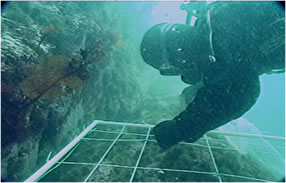Sea Urchin Reproductive Ecology (Maine Department of Marine Resources)
Participants: R. Wahle (Bigelow)
Funding agency: Maine DMR
Funding Period: 1998; 2000- 2004
Project Summary:


Over the past two decades along the Maine coast the green sea urchin has been rapidly and widely depleted by harvesting for the Japanese sushi market. There is justified concern about the consequences of harvesting for the reproductive performance of the population. This research evaluates the conflicting effects of changes in population density on reproductive output of the green sea urchin,Strongylocentrotus droebachiensis. As free-spawners that broadcast their gametes into the water, sea urchins must be highly aggregated to achieve high fertilization rates. Conversely, food limitation on crowded, over-grazed “urchin barrens” can diminish per-capita gonad production. We evaluate these reproductive trade-offs through population surveys and field experiments that obtain direct measures of gamete production and in situ fertilization rates.
Theses:
Gaudette, J. 2004. Disponibilité du sperme au cours de la saison de la ponte de l’oursin vert, Strongylocentrotus droebachiensis, dans des populations de différentes tailles. Masters Thesis. Université Laval, Quebec.
Publications:
Wahle, R.A. and H. Peckham.1999. Density-related reproductive trade-offs in the green sea urchin,Strongylocentrotus droebachiensis. Mar. Biol. 134:127-137.
Wahle, R.A. and Gilbert, A. 2002. Detecting spawning by the green sea urchin (Strongylocentrotus droebachiensis) with time-integrated fertilization assays. Mar. Biol. 140: 375-382.
Gaudette, J., R. A. Wahle, R.A., and J. Himmelman. 2006. Spawning events in small and large populations of the sea urchin, Strongylocentrotus droebachiensis. Limnol. Oceanogr. 51:1485-1496.
